transmission OPEL GT-R 1973 Manual Online
[x] Cancel search | Manufacturer: OPEL, Model Year: 1973, Model line: GT-R, Model: OPEL GT-R 1973Pages: 625, PDF Size: 17.22 MB
Page 418 of 625
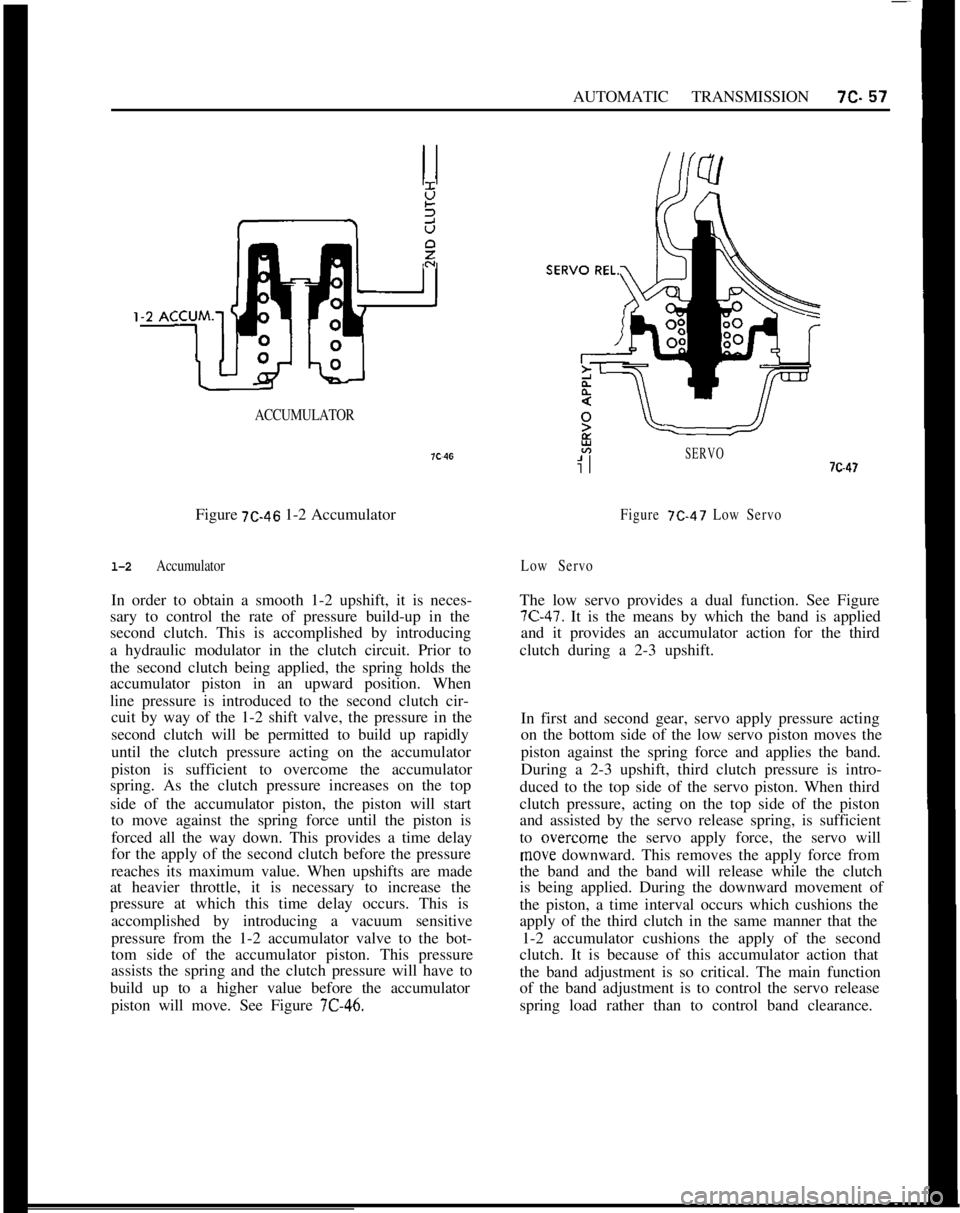
AUTOMATIC TRANSMISSION7c-57
ACCUMULATORFigure
7C-46 1-2 Accumulator
l-2 AccumulatorIn order to obtain a smooth 1-2 upshift, it is neces-
sary to control the rate of pressure build-up in the
second clutch. This is accomplished by introducing
a hydraulic modulator in the clutch circuit. Prior to
the second clutch being applied, the spring holds the
accumulator piston in an upward position. When
line pressure is introduced to the second clutch cir-
cuit by way of the 1-2 shift valve, the pressure in the
second clutch will be permitted to build up rapidly
until the clutch pressure acting on the accumulator
piston is sufficient to overcome the accumulator
spring. As the clutch pressure increases on the top
side of the accumulator piston, the piston will start
to move against the spring force until the piston is
forced all the way down. This provides a time delay
for the apply of the second clutch before the pressure
reaches its maximum value. When upshifts are made
at heavier throttle, it is necessary to increase the
pressure at which this time delay occurs. This is
accomplished by introducing a vacuum sensitive
pressure from the 1-2 accumulator valve to the bot-
tom side of the accumulator piston. This pressure
assists the spring and the clutch pressure will have to
build up to a higher value before the accumulator
piston will move. See Figure
7C-46.
SERVO7c-47
Figure 7C-47 Low Servo
Low ServoThe low servo provides a dual function. See Figure
7C-47. It is the means by which the band is applied
and it provides an accumulator action for the third
clutch during a 2-3 upshift.
In first and second gear, servo apply pressure acting
on the bottom side of the low servo piston moves the
piston against the spring force and applies the band.
During a 2-3 upshift, third clutch pressure is intro-
duced to the top side of the servo piston. When third
clutch pressure, acting on the top side of the piston
and assisted by the servo release spring, is sufficient
to overcome the servo apply force, the servo will
move downward. This removes the apply force from
the band and the band will release while the clutch
is being applied. During the downward movement of
the piston, a time interval occurs which cushions the
apply of the third clutch in the same manner that the
1-2 accumulator cushions the apply of the second
clutch. It is because of this accumulator action that
the band adjustment is so critical. The main function
of the band adjustment is to control the servo release
spring load rather than to control band clearance.
Page 420 of 625
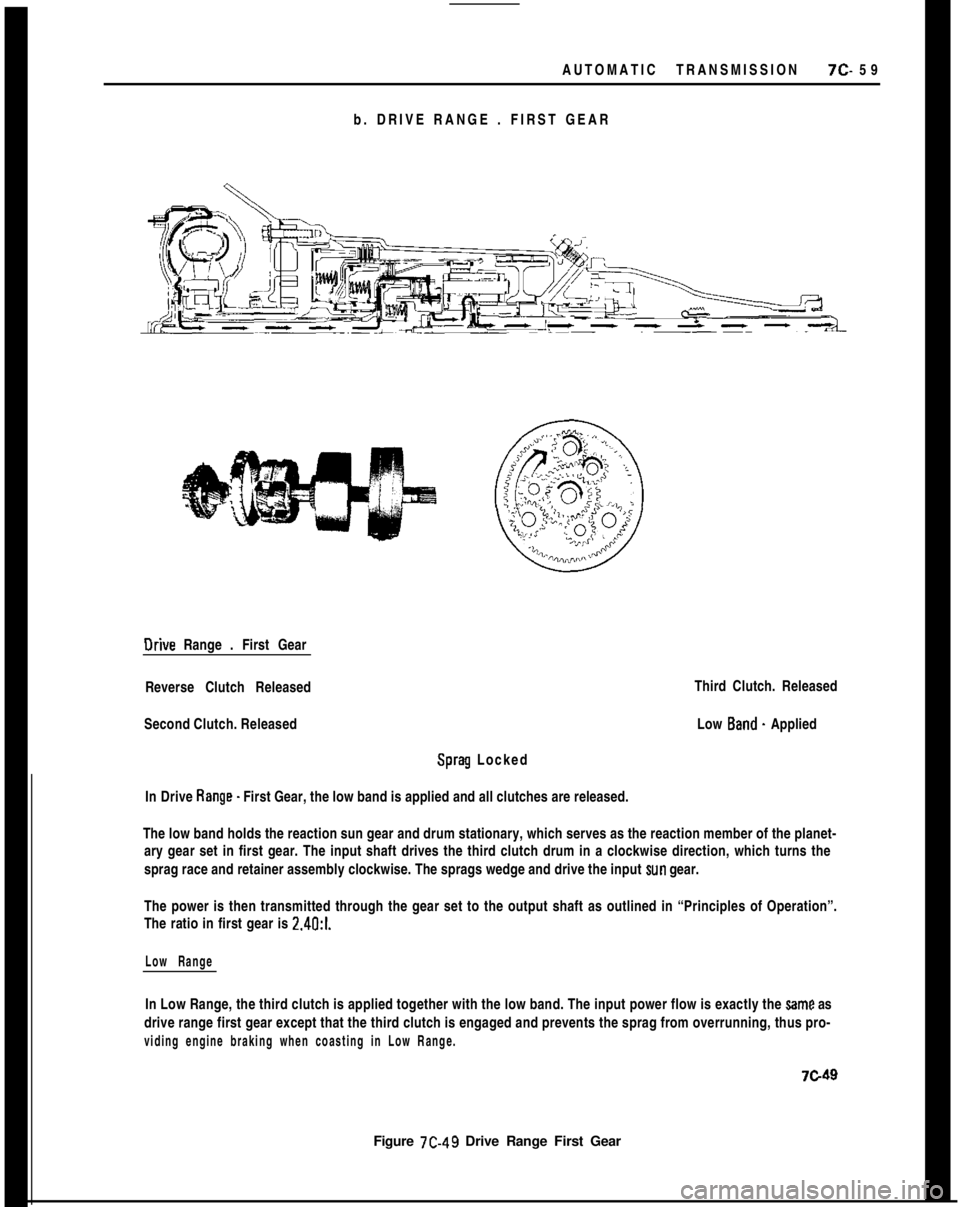
AUTOMATIC TRANSMISSION7c- 59
b. DRIVE RANGE . FIRST GEAROrive Range . First Gear
Reverse Clutch Released
Second Clutch. Released
Sprag Locked
In Drive Range. First Gear, the low band is applied and all clutches are released.
Figure 7C-49 Drive Range First GearThird Clutch. Released
Low Band. Applied
The low band holds the reaction sun gear and drum stationary, which serves as the reaction member of the planet-
ary gear set in first gear. The input shaft drives the third clutch drum in a clockwise direction, which turns the
sprag race and retainer assembly clockwise. The sprags wedge and drive the input
sun gear.
The power is then transmitted through the gear set to the output shaft as outlined in “Principles of Operation”.
The ratio in first gear is 2.4O:l.
Low RangeIn Low Range, the third clutch is applied together with the low band. The input power flow is exactly the
Same as
drive range first gear except that the third clutch is engaged and prevents the sprag from overrunning, thus pro-
viding engine braking when coasting in Low Range.
7c49
Page 422 of 625

AUTOMATIC TRANSMISSION 7C- 61
d. DRIVE RANGE - THIRD GEAR
Drive Range
- Third Gear
Reverse Clutch
- Released
Second Clutch. Applied
Sprag . LockedThird Clutch -Applied
Low Band
- Released
In Drive Range
- Third Gear, the low band is released and both the second and third clutches are applied.
In this condition, the ring gear is locked o the input sun gear. With two planetary members connected
inthismanner, the entire planetary system will rotate as a solid unit and provide a direct drive with a ratio of 1 to 1. The
input is split between the ring gear end input sun, and the rarrier is the output member.
Figure 7C-5 1 Drive Range Third Gear
Page 424 of 625

AUTOMATIC TRANSMISSION ?C- 63
Page 426 of 625
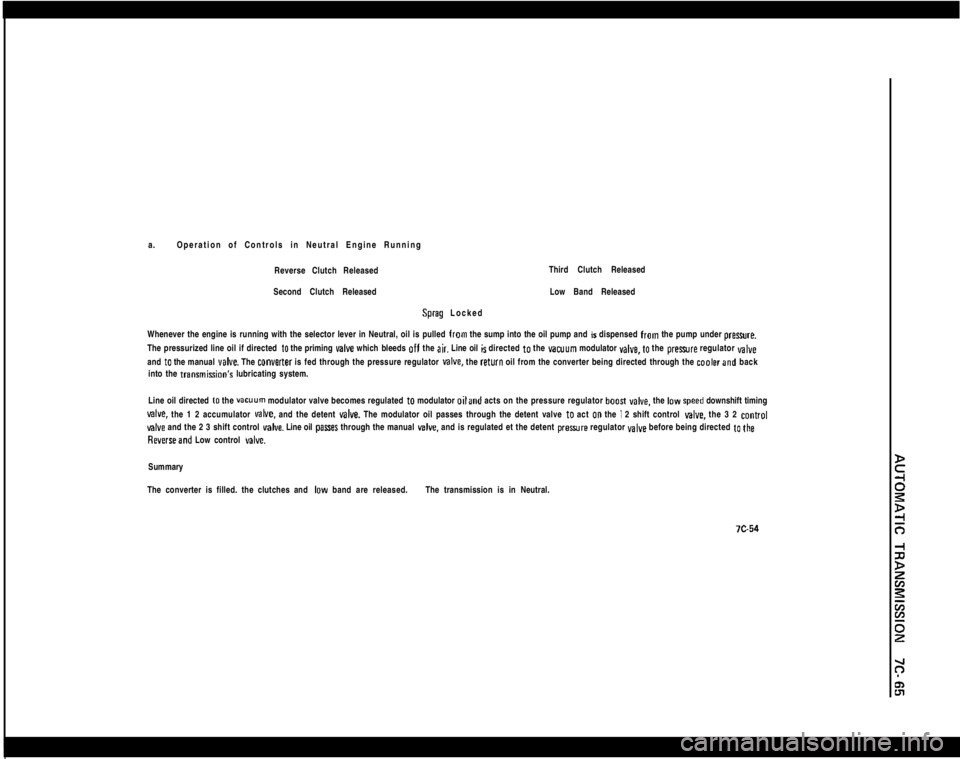
a.Operation of Controls in Neutral Engine Running
Reverse Clutch ReleasedThird Clutch Released
Second Clutch ReleasedSprag LockedLow Band Released
Whenever the engine is running with the selector lever in Neutral, oil is pulled from the sump into the oil pump and is dispensed from the pump under preure.
The pressurized line oil if directed
to the priming valve which bleeds off the air. Line oil is directed to the vacuum modulator YBIYB, to the prexwre regulator valveand
to the manual veIve. The converter is fed through the pressure regulator MIYB. the return oil from the converter being directed through the coalerand back
into the transmisGon’s lubricating system.
Line oil directed
to the vacuum modulator valve becomes regulated to modulator oiland acts on the pressure regulator boosI YBCB. the IDW speed downshift timing
valve. the 1 2 accumulator MIYB. and the detent valve. The modulator oil passes through the detent valve to act 00 the I 2 shift control give. the 3 2 control
valve and the 2 3 shift control valve. Line oil pasres through the manual v&e. and is regulated et the detent preaure regulator valve before being directed to the
Reverseand Low control delve.Summary
The converter is filled. the clutches and
IDW band are released.The transmission is in Neutral.
Page 430 of 625

c. Operation of Controls in Drive Range Second Gear
Reverse Clutch
ReleasedThird Clutch Released
Second Clutch AppliedLow Band Applied
Sprag Over Running
As the vehicle increws speed. the govwnor
allow more drive oil 10 pass through, and this increased pressure, acting on the end of the 1 2 shift
vahre. overcomes the I 2 shift valve spring pressure and allovn drive oil 10 pasr through the valve to feed the second clutch oil parsages.Second clutch oil passes through the second clutch orifice control valve, seating the ball and is metered to the second clutch piRon
to begin to apply
the second clutch, whileportion of the oil is directed
10 the accumulator. As the upper portion of the accumulator fills with second clutch oil. itovercomes the leer prewre of 1 2 accumulator oil and spring at the bottom of the accumulator piston. forcing the piston downward. The upper
portion of the accumulator is now filled, allowing full oil preaure
to the second clutch piEton far the final apply. The accumulator, therefore, acts as a
reservoir
10 produce a damping effect for a smooth second clutch apply and the 1 2 shift.
Second clutch oil from the 1 2 shift
valve is simultaneously directed to the 2 3 shift valve to be used as the oil source for the 2 3 shift.
Summary
The second clutch is on. the band is on, the transmission is in drive range
i second gear.
Page 434 of 625
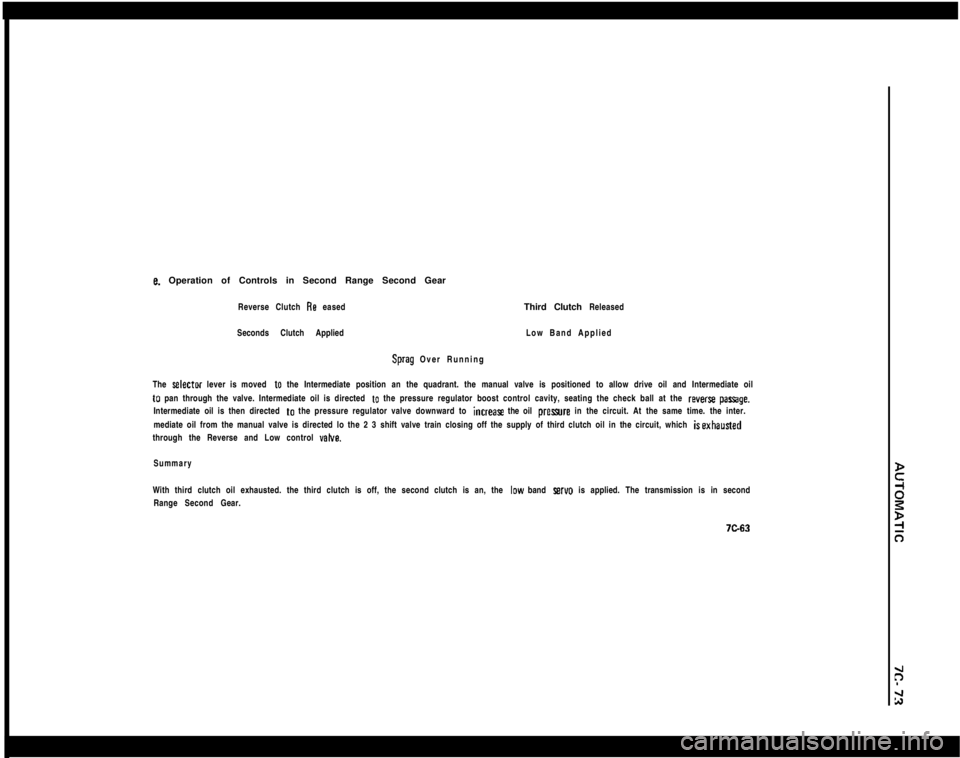
e. Operation of Controls in Second Range Second Gear
Reverse Clutch
Re easedThird Clutch Released
Seconds Clutch AppliedLow Band Applied
Sprag Over Running
The
selector lever is moved to the Intermediate position an the quadrant. the manual valve is positioned to allow drive oil and Intermediate oilto pan through the valve. Intermediate oil is directed
to the pressure regulator boost control cavity, seating the check ball at the reverse passage.Intermediate oil is then directed to the pressure regulator valve downward to
increaSe the oil prepare in the circuit. At the same time. the inter.
mediate oil from the manual valve is directed lo the 2 3 shift valve train closing off the supply of third clutch oil in the circuit, which isexhausted
through the Reverse and Low control
valve.
SummaryWith third clutch oil exhausted. the third clutch is off, the second clutch is an, the low band
servo is applied. The transmission is in second
Range Second Gear.
Page 438 of 625
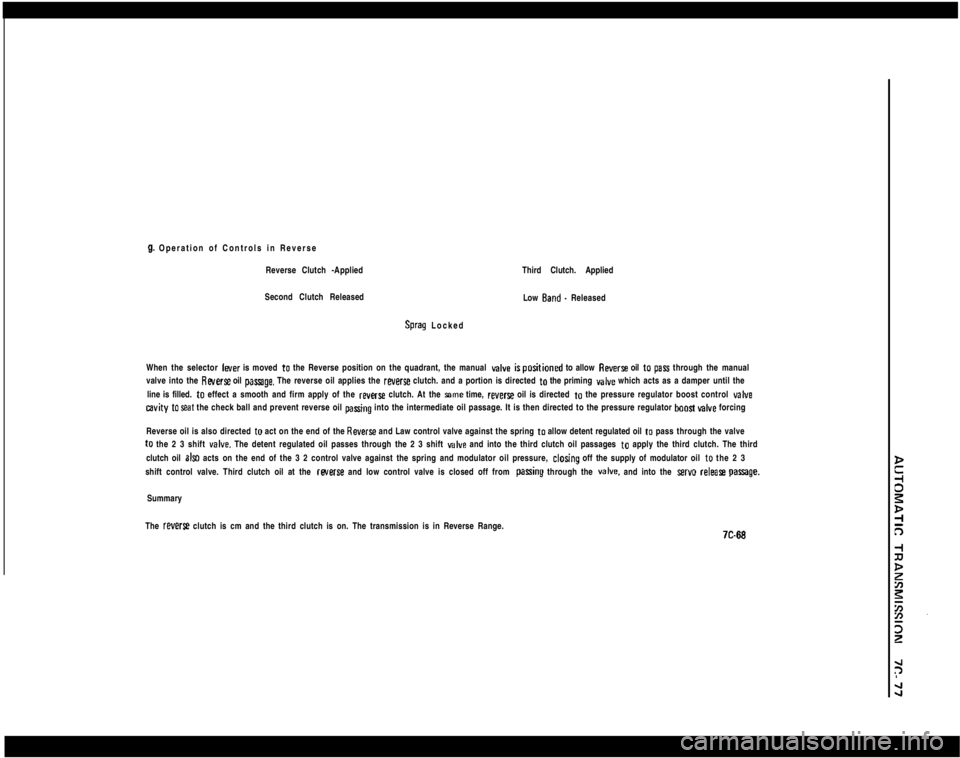
9. Operation of Controls in Reverse
Reverse Clutch -Applied
Second Clutch Released
Sprag LockedThird Clutch. Applied
Low Band. Released
When the selector leer is moved to the Reverse position on the quadrant, the manual
valve ispositioned to allow Revert oil to pars through the manual
valve into the
Reverse oil passage. The reverse oil applies the reverse clutch. and a portion is directed to the priming valve which acts as a damper until the
line is filled. to effect a smooth and firm apply of the
reverss clutch. At the wne time, reverse oil is directed to the pressure regulator boost control valve
cavity to seat the check ball and prevent reverse oil pasring into the intermediate oil passage. It is then directed to the pressure regulator boast valve forcing
Reverse oil is also directed to act on the end of the
Reverse and Law control valve against the spring to allow detent regulated oil to pass through the valveto the 2 3 shift
valve. The detent regulated oil passes through the 2 3 shift valve and into the third clutch oil passages to apply the third clutch. The third
clutch oil
al= acts on the end of the 3 2 control valve against the spring and modulator oil pressure, clodng off the supply of modulator oil to the 2 3
shift control valve. Third clutch oil at the rwerse and low control valve is closed off from
parring through the valve. and into the servo releal~ parrage.Summary
The
reverse clutch is cm and the third clutch is on. The transmission is in Reverse Range.
Page 442 of 625
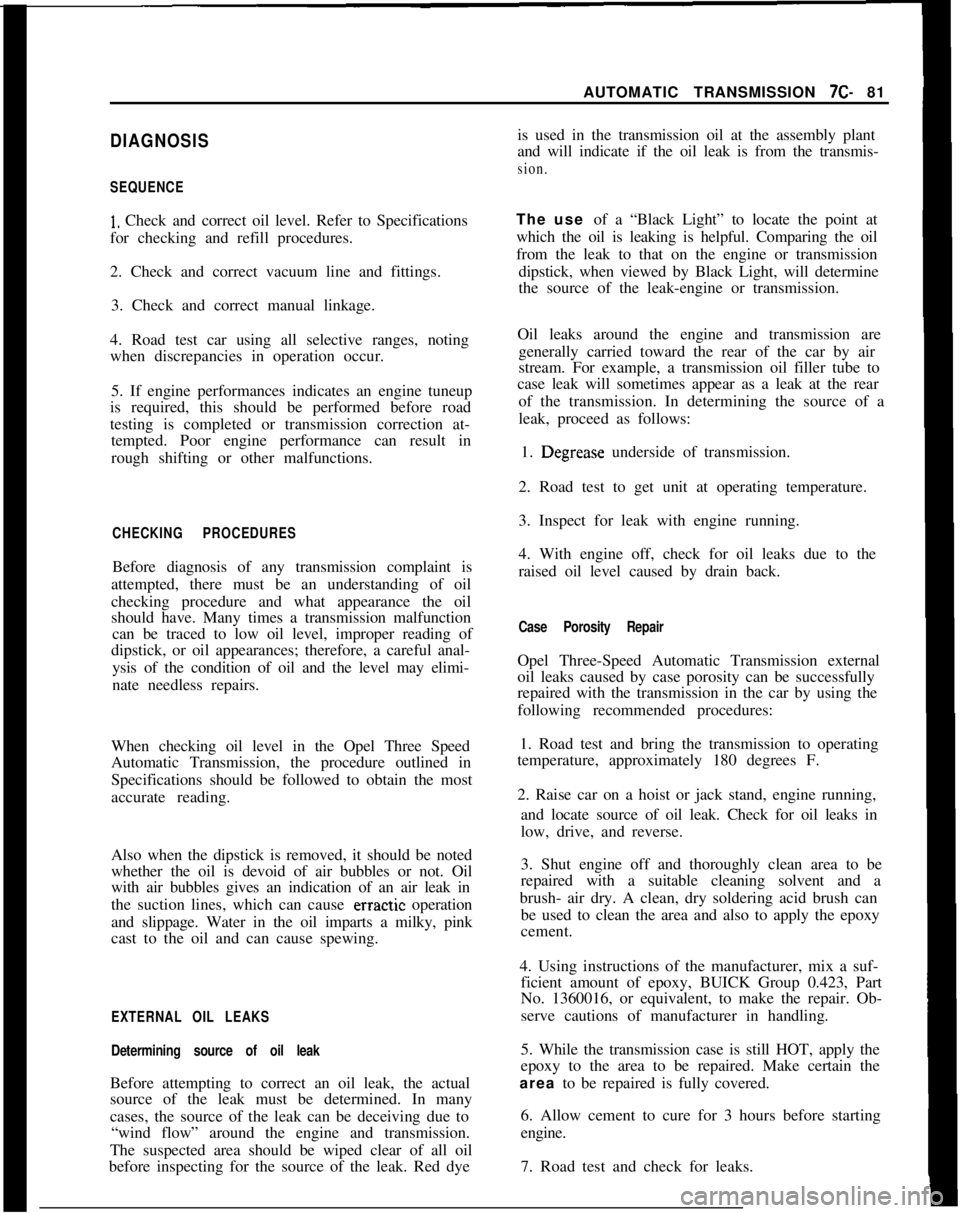
DIAGNOSIS
SEQUENCE
1. Check and correct oil level. Refer to Specifications
for checking and refill procedures.
2. Check and correct vacuum line and fittings.
3. Check and correct manual linkage.
4. Road test car using all selective ranges, noting
when discrepancies in operation occur.
5. If engine performances indicates an engine tuneup
is required, this should be performed before road
testing is completed or transmission correction at-
tempted. Poor engine performance can result in
rough shifting or other malfunctions.
CHECKING PROCEDURESBefore diagnosis of any transmission complaint is
attempted, there must be an understanding of oil
checking procedure and what appearance the oil
should have. Many times a transmission malfunction
can be traced to low oil level, improper reading of
dipstick, or oil appearances; therefore, a careful anal-
ysis of the condition of oil and the level may elimi-
nate needless repairs.
When checking oil level in the Opel Three Speed
Automatic Transmission, the procedure outlined in
Specifications should be followed to obtain the most
accurate reading.
Also when the dipstick is removed, it should be noted
whether the oil is devoid of air bubbles or not. Oil
with air bubbles gives an indication of an air leak in
the suction lines, which can cause erractic operation
and slippage. Water in the oil imparts a milky, pink
cast to the oil and can cause spewing.
EXTERNAL OIL LEAKS
Determining source of oil leakBefore attempting to correct an oil leak, the actual
source of the leak must be determined. In many
cases, the source of the leak can be deceiving due to
“wind flow” around the engine and transmission.
The suspected area should be wiped clear of all oil
before inspecting for the source of the leak. Red dyeAUTOMATIC TRANSMISSION 7C- 81
is used in the transmission oil at the assembly plant
and will indicate if the oil leak is from the transmis-
sion.The use of a “Black Light” to locate the point at
which the oil is leaking is helpful. Comparing the oil
from the leak to that on the engine or transmission
dipstick, when viewed by Black Light, will determine
the source of the leak-engine or transmission.
Oil leaks around the engine and transmission are
generally carried toward the rear of the car by air
stream. For example, a transmission oil filler tube to
case leak will sometimes appear as a leak at the rear
of the transmission. In determining the source of a
leak, proceed as follows:
1. Degrease underside of transmission.
2. Road test to get unit at operating temperature.
3. Inspect for leak with engine running.
4. With engine off, check for oil leaks due to the
raised oil level caused by drain back.
Case Porosity RepairOpel Three-Speed Automatic Transmission external
oil leaks caused by case porosity can be successfully
repaired with the transmission in the car by using the
following recommended procedures:
1. Road test and bring the transmission to operating
temperature, approximately 180 degrees F.
2. Raise car on a hoist or jack stand, engine running,
and locate source of oil leak. Check for oil leaks in
low, drive, and reverse.
3. Shut engine off and thoroughly clean area to be
repaired with a suitable cleaning solvent and a
brush- air dry. A clean, dry soldering acid brush can
be used to clean the area and also to apply the epoxy
cement.
4. Using instructions of the manufacturer, mix a suf-
ficient amount of epoxy, BUICK Group 0.423, Part
No. 1360016, or equivalent, to make the repair. Ob-
serve cautions of manufacturer in handling.
5. While the transmission case is still HOT, apply the
epoxy to the area to be repaired. Make certain the
area to be repaired is fully covered.
6. Allow cement to cure for 3 hours before starting
engine.
7. Road test and check for leaks.
Page 443 of 625
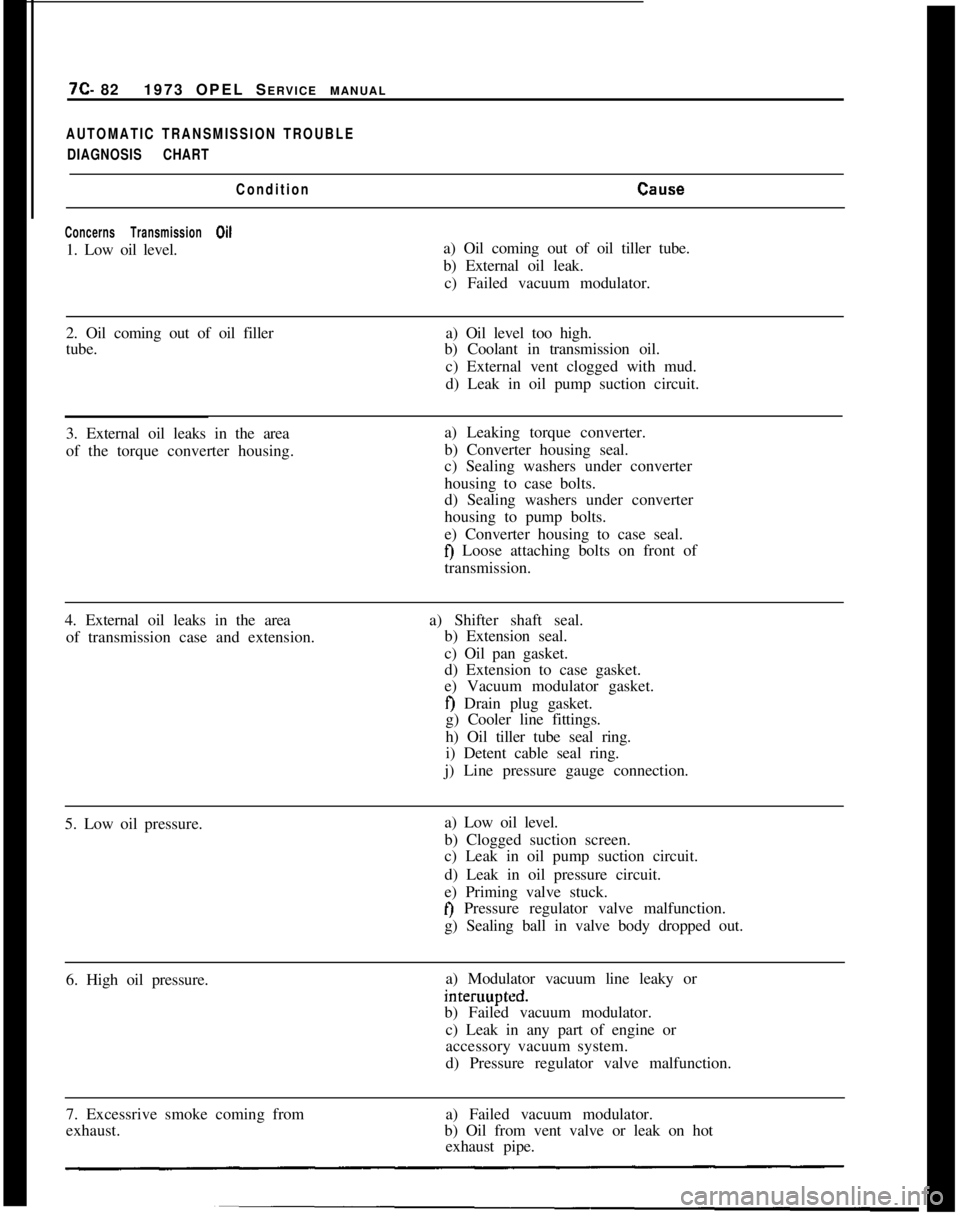
7C- 821973 OPEL SERVICE MANUALAUTOMATIC TRANSMISSION TROUBLE
DIAGNOSIS CHART
Condition
CEllE.e
Concerns Transmission Oil1. Low oil level.a) Oil coming out of oil tiller tube.
b) External oil leak.
c) Failed vacuum modulator.
2. Oil coming out of oil filler
tube.a) Oil level too high.
b) Coolant in transmission oil.
c) External vent clogged with mud.
d) Leak in oil pump suction circuit.
3. External oil leaks in the area
of the torque converter housing.a) Leaking torque converter.
b) Converter housing seal.
c) Sealing washers under converter
housing to case bolts.
d) Sealing washers under converter
housing to pump bolts.
e) Converter housing to case seal.
fj Loose attaching bolts on front of
transmission.
4. External oil leaks in the area
of transmission case and extension.a) Shifter shaft seal.
b) Extension seal.
c) Oil pan gasket.
d) Extension to case gasket.
e) Vacuum modulator gasket.
f) Drain plug gasket.
g) Cooler line fittings.
h) Oil tiller tube seal ring.
i) Detent cable seal ring.
j) Line pressure gauge connection.
5. Low oil pressure.a) Low oil level.
b) Clogged suction screen.
c) Leak in oil pump suction circuit.
d) Leak in oil pressure circuit.
e) Priming valve stuck.
t) Pressure regulator valve malfunction.
g) Sealing ball in valve body dropped out.
6. High oil pressure.a) Modulator vacuum line leaky orinteruupted.
b) Failed vacuum modulator.
c) Leak in any part of engine or
accessory vacuum system.
d) Pressure regulator valve malfunction.
7. Excessrive smoke coming from
exhaust.a) Failed vacuum modulator.
b) Oil from vent valve or leak on hot
exhaust pipe.